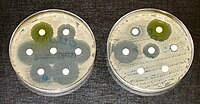
Photo from wikipedia
OBJECTIVES This meta-analysis aimed to evaluate the current prevalence and trends over the past 10 years of Pseudomonas aeruginosa (P. aeruginosa) antimicrobial resistance. Two researches independently searched two national (ULAKBİM,… Click to show full abstract
OBJECTIVES This meta-analysis aimed to evaluate the current prevalence and trends over the past 10 years of Pseudomonas aeruginosa (P. aeruginosa) antimicrobial resistance. Two researches independently searched two national (ULAKBİM, Türk Medline) and two international databases (PubMed, Web of Science) to identify studies on P. aeruginosa resistance to antimicrobials from 2007 to 2017. METHODS Homogeneity across studies was assessed using Cochrane guidelines, and total variability due to between-study variations was reflected in the I2 index. A random effects model was developed to estimate the antimicrobial resistance rates and their corresponding 95% CI. Pooled antibiotic resistance rates between 2007-2011 and 2012-2016 were compared to calculate the change in antibiotic resistance over time. Electronic searches with MeSH terms and text words identified 1017 papers. After applying exclusion and inclusion criteria, 45 articles were selected. RESULTS Pooled resistance prevalence of P. aeruginosa to piperacillin-tazobactam, ceftazidime, cefepime, meropenem, imipenem, ciprofloxacin, gentamicin, amikacin, tobramycin and colistin were 33.9%, 38.6%, 35.6%, 30.1%, 28.0%, 30.7%, 28.2%, 17.8%, 15.7% and 2.2%, respectively. The resistance rates of piperacillin, piperacillin-tazobactam, imipenem, meropenem, amikacin and colistin significantly increased in the second 5 years (P<0.05); however, gentamicin, tobramycin and ciprofloxacin resistance rates significantly decreased (P<0.05). Comparing the resistance rates between the isolates of intensive care unit (ICU) patients and non-ICU patients, meropenem and piperacillin-tazobactam resistance in ICU isolates were significantly higher than non-ICU (P<0.05). CONCLUSIONS These results suggest that antibiotic resistance is high in P. aeruginosa and the trends in antimicrobial resistance continue to increase, mainly in carbapenems and penicillins, in Turkey.
Journal Title: Journal of global antimicrobial resistance
Year Published: 2019
Link to full text (if available)
Share on Social Media: Sign Up to like & get
recommendations!